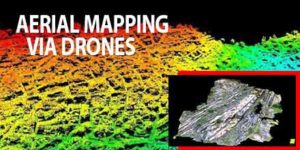
The surveying and mapping industry has used photogrammetry and LiDAR (Light Detection and Ranging) for many years, Questions over which is best have gone on for just as long.
Choosing between photogrammetry and LiDAR is not a case of which offers superior technology but, rather, which is better suited for the surveying purposes required. Professionals working in the sector understand that both have their benefits.
Photogrammetry uses pictures to take measurements whereas
LiDAR uses lasers and light to do the same. For mapping and surveying bare earth regions, photogrammetry is a great choice. But for areas with heavy vegetation or other obstructions in the way of the site being surveyed, LiDAR provides the best fit.
Drone technology takes flight
Drone technology has made a huge impact on aerial mapping and surveying. Drones offer many advantages including the ability to capture photos at predefined elevations and at a predetermined overlap percentage.
In the past, conventional aerial LiDAR providers turned down surveying projects on areas under 5 square kilometers because it simply wasn't cost effective. Today, drones mounted with LiDAR systems, can map these same areas quickly, affordably and with far less logistical issues.
In turn, while drone mounted LiDAR systems achieve great results, their cost and using them over larger areas may not be currently feasible.
UAV LiDAR systems also offer image control and perspectives unique from traditional capture methods. Drone operators too have the flexibility to configure the vehicles to gather large volumes of data and capture images that are perfect for what the application requires.
The affordability of drones also means that aerial surveying and mapping has attracted more people to the industry. This translates into varying skill and experience levels which inevitably brings about mixed surveying results. In the same way, organizations that rely on surveying data have also decided on an in-house approach.
Acquiring Accurate Imagery
Regardless of whether a surveyor chooses photogrammetry or LiDAR, the ultimate goal is to acquire accurate imagery.
Surveyors begin by determining the level of accuracy they require, which drives the decision between LiDAR and photogrammetry.
Generally, LiDAR achieves more accurate results but is limited when it comes to obtaining high resolution images through the technology's data. Often, individual use traditional photogrammetry methods to augment the LiDAR data.
Surveyors often choose what they are more familiar with, as well as what is more affordable. While there is nothing wrong with such an approach, it is important to keep in mind that the requirements of each project will vary, as will their cost.
The use of UAV LiDAR or photogrammetry alone may work for one project while other missions may require the use of both technologies to achieve the desired imagery.
Some surveyors forego LiDAR and photogrammetry entirely, choosing instead photo-based solutions. Though initial costs may be more affordable, redoing everything means expenses can mount quickly.
Varied Capabilities and Cost
Currently, LiDAR is not as readily available in mainstream technology but options continue to increase. Still with the right drone and a camera of reasonable quality, surveyors can achieve workable measurements.
If a project's requirements are accurately followed, photogrammetry produces accurate 3D models. Its low cost also means it's the most common choice for surveying.
Today, even inexperienced operators can capture images to create a 3D demo. However, the quality of the work determines the quality of the data.
Research and due Diligence
When considering LiDAR or photogrammetry, it is important to remember that the choice is not about which is better. Both offer advantages and disadvantages.
Limitations presented by technology capabilities, terrain, as well as the size of the area all come into play.
Given the choice most surveyors would happily choose both technologies to utilize as they see fit. Those interested in surveying via drone should learn as much as they can about both technologies to determine which works best for their situation.
 The surveying and mapping industry has used photogrammetry and LiDAR (Light Detection and Ranging) for many years, Questions over which is best have gone on for just as long.
Choosing between photogrammetry and LiDAR is not a case of which offers superior technology but, rather, which is better suited for the surveying purposes required. Professionals working in the sector understand that both have their benefits.
Photogrammetry uses pictures to take measurements whereas LiDAR uses lasers and light to do the same. For mapping and surveying bare earth regions, photogrammetry is a great choice. But for areas with heavy vegetation or other obstructions in the way of the site being surveyed, LiDAR provides the best fit.
The surveying and mapping industry has used photogrammetry and LiDAR (Light Detection and Ranging) for many years, Questions over which is best have gone on for just as long.
Choosing between photogrammetry and LiDAR is not a case of which offers superior technology but, rather, which is better suited for the surveying purposes required. Professionals working in the sector understand that both have their benefits.
Photogrammetry uses pictures to take measurements whereas LiDAR uses lasers and light to do the same. For mapping and surveying bare earth regions, photogrammetry is a great choice. But for areas with heavy vegetation or other obstructions in the way of the site being surveyed, LiDAR provides the best fit.

